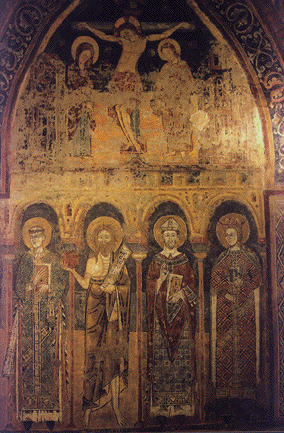San Paolo
| It had been built between 1224 and 1253 and it was the seat of the convent of the Dominican Friars; the bell tower dates back to the beginning of the V century. The confraternity moved in from the Church of S. Pietro La Ferla, out of Porta Aralda, which was less safe in that period of battles. The whole building, finished only in the XV century, represents a clear example of the convents in the town. During the ages, both the church and the cloister had been refurbished and tranformed. In 1792 a project had been undertaken: the front of the church had to be refurbished in Baroque style. Fortunalety this project had never been carried out. In 1802 the church became a store and barracks, in consequence of the suppression of the religious institutions by the French domination guided by Napoleon. In 1813 the Commune bought the convent to move in from the palace of the Barnabini (now the Prefettura). The refurbishment finished in 1843. In 1820 the church opened again, with the name of the next parish, S. Tommaso. The romanic façade of the church, with two quadrifore and a rose-window; the bell-tower and the apse, visible from the back yard, present still today the original characteristics. In the church are kept two pictures by the painter Bernardino Lanino: An Annunciation and a Lady of the Graces. In an aisle between the right nave and the sacristy you can see a beautiful and not famous set of frescoes of the early IV century. These works, formed by a set of Saints among which stands out a Sant'Ambrogio on the throne, have recently been refurbished and they present a remarkable influence of the Byzantine art. In the garret of the bell-tower, an impressive white memorial stone has been employed to support the girders of the roof. The memorial stone was probably part of the roman necropolis of the town, it keeps the original inscription, in which you can read: " T. Arruntio T. f:". Over the inscription there is a tympanum with a moulding in which are carved two dolphins separated by a double trident. Over the tympanum there are two other dolphins carved on parapets on which are based two sculptures of lions. The memorial stone, on the top, is completed by a part of a parallelepiped, maybe a decorative element. This work, is dated back to the first imperial age, between the first century B.C. and the first century A.D. The monument should have been moved in a museum, but it has the function to support the wooden girders of the bell-tower roof. In the aisle of the sacristy was once walled a sandstone sarcophagus with a high-relief and a number of graffiti dated back to the XIV century and the XV century. Today the sarcophagus is kept in the Leone Museum. (More: click here). The convent is now seat of the municipality of Vercelli. |





La chiesa ed ex convento di S. Paolo (palazzo civico).
Fu la sede del convento dei Domenicani, eretta fra il 1224 ed il 1253; il campanile è dell'inizio del Quattrocento. La congregazione vi si trasferì dalla chiesa di S. Pietro la Ferla, fuori porta Aralda, meno sicura in quei tempi di lotte e torbidi. Il complesso, terminato solo nel XV secolo, rappresenta un esempio ancora ben leggibile dei molti conventi presenti in città. Nel tempo sia il chiostro che la chiesa hanno subito restauri e trasformazioni. Nel 1792 furono intrapresi grossi lavori di modifica comprendenti il progetto per la facciata barocca della chiesa. Fortunatamente non furono compiuti. Con la soppressione napoleonica degli enti religiosi del 1802 la chiesa venne adibita a magazzino e caserma. Nel 1813 il Comune acquistò il convento per trasferirvi la propria sede dal palazzo dei Barnabiti (attuale Prefettura). I lavori di ristrutturazione terminarono nel 1843. La chiesa venne riaperta al culto nel 1820 con il trasferimento del titolo della vicina parrocchia di S. Tommaso. La facciata romanica della chiesa, con le due quadrifore ed il rosone, presenta tuttora i caratteri originari con pochi rifacimenti, così pure il campanile e l'abside, ben visibili nel cortile posteriore. Nella chiesa sono conservate due belle tavole del pittore cinquecentesco Bernardino Lanino: un'Annunciazione e la Madonna delle Grazie. In un corridoio fra la navata destra e la sacrestia si può ammirare un bellissimo e poco noto ciclo di affreschi del primo Trecento. Recentemente restaurati gli affreschi, pervasi da marcate ascendenze bizantine, sono costituiti da una teoria di Santi fra cui domina un Sant'Ambrogio in trono. Nel sottotetto del campanile, inoltre, è riutilizzato, a sostegno delle travature del tetto, un imponente e ben conservato cippo funerario In marmo bianco, certamente proveniente da una delle aree necropolari romane della città. Il cippo conserva la prima linea del testo che costituiva l'iscrizione, nella quale si legge: "T. Arruntio T. f.". Sormontante l'iscrizione è un timpano con cornice modanata all'interno del quale sono scolpiti due delfini separati al centro da un doppio tridente. Al di sopra del timpano sono poi altri due delfini scolpiti su due spallette laterali sulle quali poggiano due ulteriori sculture che raffigurano leoni. Completa il cippo, verso l'alto, la parte troncata di un parallelepipedo, forse decorativo. Il manufatto, di complessa e buona fattura, è databile alla prima età imperiale, tra il I secolo a.C ed il I secolo d.C. Il monumento dovrebbe essere asportato e musealizzato, ciò non è però facilmente realizzabile vista la funzione di sostegno alle strutture lignee del tetto del campanile. (v. carta archeologica della città http://members.xoom.virgilio.it/vercellae/104-10 Tx.htm) Nel corridoio della sacrestia era infine un tempo murato il bellissiomo sarcofago in arenaria con altorilievo ora conservato al Museo Leone, coperto da un gran numero di interessanti graffiti spontanei databili fra il XIV ed il XV secolo (per approfondimenti http://www.archeovercelli.it/graffiti2.htm). Il convento è tuttora sede del Municipio. gs
|
![]()